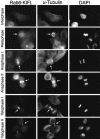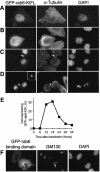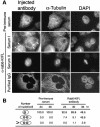The Rab6-binding kinesin, Rab6-KIFL, is required for cytokinesis
- PMID: 11060022
- PMCID: PMC305783
- DOI: 10.1093/emboj/19.21.5711
The Rab6-binding kinesin, Rab6-KIFL, is required for cytokinesis
Abstract
The Rab6-binding kinesin, Rab6-KIFL, was identified in a two-hybrid screen for proteins that interact with Rab6, a small GTPase involved in membrane traffic through the Golgi apparatus. We find that Rab6-KIFL accumulates in mitotic cells where it localizes to the midzone of the spindle during anaphase, and to the cleavage furrow and midbody during telophase. Overexpression of Rab6-KIFL causes a cell division defect resulting in cell death. Microinjection of antibodies to Rab6-KIFL results in the cells becoming binucleate after one cell cycle, and time-lapse microscopy reveals that this is due to a defect in cleavage furrow formation and thus cytokinesis. These data show that endogenous Rab6-KIFL functions in cell division during cleavage furrow formation and cytokinesis, in addition to its previously described role in membrane traffic.
Figures








Similar articles
-
Assay and functional properties of Rabkinesin-6/Rab6-KIFL/MKlp2 in cytokinesis.Methods Enzymol. 2005;403:618-28. doi: 10.1016/S0076-6879(05)03054-5. Methods Enzymol. 2005. PMID: 16473625
-
The human kinesin-like protein RB6K is under tight cell cycle control and is essential for cytokinesis.Mol Cell Biol. 2001 Apr;21(8):2944-55. doi: 10.1128/MCB.21.8.2944-2955.2001. Mol Cell Biol. 2001. PMID: 11283271 Free PMC article.
-
The Drosophila kinesin-like protein KLP3A is a midbody component required for central spindle assembly and initiation of cytokinesis.J Cell Biol. 1995 May;129(3):709-23. doi: 10.1083/jcb.129.3.709. J Cell Biol. 1995. PMID: 7730406 Free PMC article.
-
Microtubules, membranes and cytokinesis.Curr Biol. 2000 Oct 19;10(20):R760-70. doi: 10.1016/s0960-9822(00)00746-6. Curr Biol. 2000. PMID: 11069103 Review.
-
A role for rab7 GTPase in growth factor-regulated cell nutrition and apoptosis.Mol Cell. 2003 Oct;12(4):796-7. doi: 10.1016/s1097-2765(03)00401-5. Mol Cell. 2003. PMID: 14580329 Review.
Cited by
-
Identification of cytoskeleton-associated proteins essential for lysosomal stability and survival of human cancer cells.PLoS One. 2012;7(10):e45381. doi: 10.1371/journal.pone.0045381. Epub 2012 Oct 11. PLoS One. 2012. PMID: 23071517 Free PMC article.
-
The ETS transcription factors ELK1 and GABPA regulate different gene networks to control MCF10A breast epithelial cell migration.PLoS One. 2012;7(12):e49892. doi: 10.1371/journal.pone.0049892. Epub 2012 Dec 20. PLoS One. 2012. PMID: 23284628 Free PMC article.
-
The localization of inner centromeric protein (INCENP) at the cleavage furrow is dependent on Kif12 and involves interactions of the N terminus of INCENP with the actin cytoskeleton.Mol Biol Cell. 2007 Sep;18(9):3366-74. doi: 10.1091/mbc.e06-10-0895. Epub 2007 Jun 13. Mol Biol Cell. 2007. PMID: 17567958 Free PMC article.
-
Identification of a glycolysis-related gene signature for predicting prognosis in patients with hepatocellular carcinoma.BMC Cancer. 2022 Feb 5;22(1):142. doi: 10.1186/s12885-022-09209-9. BMC Cancer. 2022. PMID: 35123420 Free PMC article.
-
A role for the Rab6A' GTPase in the inactivation of the Mad2-spindle checkpoint.EMBO J. 2006 Jan 25;25(2):278-89. doi: 10.1038/sj.emboj.7600929. Epub 2006 Jan 5. EMBO J. 2006. PMID: 16395330 Free PMC article.
References
-
- Allan V.J. and Schroer,T.A. (1999) Membrane motors. Curr. Opin. Cell Biol., 11, 476–482. - PubMed
-
- Barr F.A. (1999) A novel Rab6-interacting domain defines a family of Golgi-targeted coiled-coil proteins. Curr. Biol., 9, 381–384. - PubMed
-
- Boman A.L., Kuai,J., Zhu,X., Chen,J., Kuriyama,R. and Kahn,R.A. (1999) Arf proteins bind to mitotic kinesin-like protein 1 (MKLP1) in a GTP-dependent fashion. Cell Motil. Cytoskel., 44, 119–132. - PubMed
Publication types
MeSH terms
Substances
LinkOut - more resources
Full Text Sources
Other Literature Sources
Molecular Biology Databases

